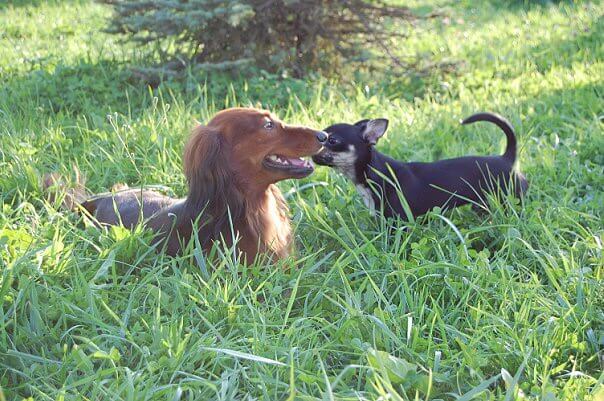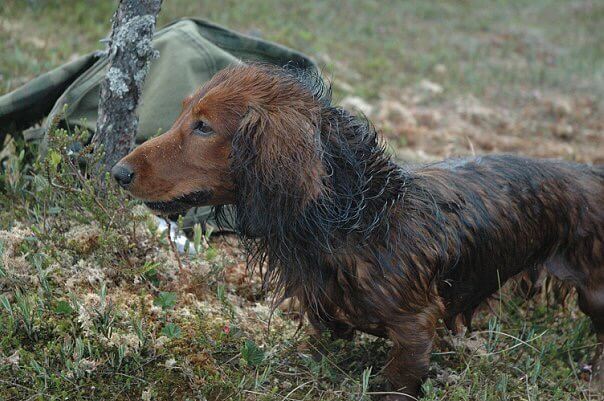Can a dachshund be trained? What are the best training techniques? How long will my dachshund training take? Is it difficult? Why don’t I just send my sausage dog to obedience school? This is just a few out of the barrage of questions I am asked by dachshund owners all the time.
As a result, when it comes to dachshund training, most people think that they are a challenging species to deal with.
There is a popular misconception about the poor little dachshund. Sausage dogs are known for their stubborn, strong-willed character.
This satement can’t be any further from the truth.
I strongly believe that training your dachshund is just as difficult as training any other dog breed if, at all I can even say from experience, they’re one of the easier breeds to train.
After all, if you take into consideration some specific traits of their personality, sausage dogs are smart and devoted creatures. Also, they are very eager to spend time with you, and they will happily engage in the training process.
It is crucial to set the training process in the right way, know the strong points of you and your Sausage dog and also, its weak points too.
So, if you are struggling with your Dachshund, and need a little help, we are here for you.
On our website, you will find enough detailed step-by-step Dachshund training guide and expert advice and to help you every step of the way.
Table of Contents
Main principles of dachshund training

Dogs in general, and Dachshunds particularly, are very smart, agile and strong-willed creatures, add a dose of loyalty to the mix and you end up with man’s best friend.
First of all, wiener dogs are very intuitive and are bursting with energy. They have a very acute sense of smell as well an equally strong drive to chase after prey; this is because they were bred to stay focused and follow a trail without getting distracted by anything.
If your pet dachshund is busy, probably with a bone toy, a ball or another chewable or something more interesting, they may not always pay attention to you or it may be a little hard to get his attention back.
These situations make your very own sausage dog a little challenge to train. Nevertheless, they are a very cute tiny handful.
To make your dachshund training more effective, it’s always best to know and follow couple of main training principles:
Start training when your dachshund is a puppy

When it comes to training dachshunds or any dog at all, it is advised that you start their training when they are young.
This is because as your pet grows older he becomes used to certain habits and behaviours, and these habits may be more difficult for you to break.
Even as human beings, we always start instilling good behaviours into our children from when they’re young. We know how easy it is for us to pick bad habits and how difficult it gets when we have to break it.
This is equally very true for pets too. Dachshund puppy training is essential as the foundation of learning the tips and tricks to having your perfect pet companion.
The best training method for a dachshund is reward based training

Dachshunds are very emotional creatures, and the best training method for getting them behaving properly is the REWARD BASED training.
This method is very effective because dachshunds love to shower their owner with a lot of attention and affection; all they ask back in return is some positive affection and attention too.
Sausage dogs are very sensitive; they’re little joy bundles and do not do well at all with loud, harsh commands or punishment.
If you’re already breaking into a sweat and thinking about how difficult it may seem to train your dachshund yourself from a puppy to an adult dog, do not worry, as long as you have a little extra patience and consistency, and you’re good to go.
We will show you how to train your dachshund, fill you in on some of the essential tips and secrets of a proper training and all the other little things you might need to know along the way.
Dachshund Training Tips
Socializing Your Dachshund
Dachshunds have been bred to be top notch trackers and highly effective hunting dogs irrespective of how they might look, and because of this they tend to be very suspicious of new people or pets around them.
Socializing your dog is the most important step in training your sausage pet. Dachshunds require a lot of outdoor time to soak in sunlight, different people and other animals.

The effect of poor socializing when the dog is young becomes apparent when the adult dachshund growls, barks, suddenly urinate or run away from strange animals or people. Once developed, suspiciousness becomes a permanent behavior trait.
Socialization of your pet dachshund should start when it is as little as six weeks all the way till he is six months old.
In some cases, socialization must continue for a little while longer. Your dachshund will only get comfortable if it is around familiar people and animals.
They will only become relaxed with the people or animals with which they live on a regular basis.
Socialization can be very simple and fun. It requires your dachshund basic training procedure.
Simply separate it into easy stages. At each step, bear in mind that the objective is to keep the optimum wellbeing of your Dachshund while having him remember you as its pillar of certainty, authority, and security.
After you have developed a decent bond through surface investigations, contact preparing, and difficulties of individual space, head out with you into a bustling outdoor spot.
Once more, ensure your pup is restrained for this, as the fact of the matter is for her to consider you to be its source of order and security.
How To Potty Train Your Dachshund
In the event that you don’t need your existence filled with wiping off after your sausage dog constantly, and your entire house smelling foul, you would require a compelling house training plan early in your puppy’s life.
Dachshund reacts enormously to positive training, and this comes handy in potty training them. So ensure you treat your dachshund whenever it goes out to do either a number 2 or 3. This treat lets her know it is positive action and will urge her to do it more.
Until your young doggie is aware that she is not to ease itself in the house, she must be restricted. This works since puppies are clean animals and would not ease themselves in the same spaces they eat and rest.
In case you’re home, you have to keep your sausage hound with you or close to you. This is generally in light of the fact that hounds are usually doing something sinister when they’re alone. Have you ever heard the saying, “the quiet pooch is probably up to no good?”
Dachshunds are little dogs. Little dogs with little bladders. This means they have little bladders too, don’t make them hold it in for too long. In fact making them hold their urine for too long can cause a urinary tract infection.
Ensure you always take them out absolute first thing at mornings, the last thing before bed, and when they are still little, you may need to get up and take them out at midnight to take a leak.
The best way to help your dachshund live longer?
Watch our video to find out!
Training Dachshund Not To Jump
“Each time a dog jumps up on the bed, jumps for the ball, or jumps into the back of the SUV, the spine is flexed and then acutely extended, putting increased forces at the low cervical, mid-thoracic, and especially lower lumbar spine. These recurring stresses can result in chronic fatigue and microscopic damage to the IVD”, says top canine surgeon Scot Swainson, DVM, ACVS of Colorado canine orthopaedics.
Dachshunds are very prone to back problems and because of their short legs and long spinal system jumping down from high places has a really negative effect on their body, there are two main tricks to train your dachshund from jumping down from high places and the work hand in hand.

The whole idea is to stop your dog from access to high areas to jump from and also train it to stop jumping. Get ready to play a game of treating.
The first step is to reduce places for him to jump down from, if you’re not sitting on your chair, put a cushion on it, or if they’re empty shelves around, fill them with books or other items to block its access to the high spaces.
The next step to reinforce this behavior is the training part. With the provision of a ramp for your sausage puppy, you begin Clicker training.
With a handheld clicker, you tell your dachshund when he is presently doing the right thing, and that has learned earned himself a great reward from you. When the clicking stops your sausage dog knows he is doing something wrong and there’d be no treat for him.
This trick comes really handy when you’re teaching your dachshund how to use its doggy ramp properly.
How to train your Dachshund to stop barking
Many hunting dogs have a tendency to bark, and dachshunds are no exception. Scent hounds generally have been trained over time to give vocal signals to announce the presence of their prey.
Beagles, Coonhounds, Foxhounds, and other dog species present in this group are quite vocal – although they do tend to bay rather than yap.
I know what you’re thinking now, how do you train a dog not to bark? That’s like telling a fish to stop swimming.
Barking may be as natural to dogs the same way it is for human beings to bust into a dance when their favorite song comes on. But trust me you can, you can train your Sausage dog when and when not to bark.
Sausage dogs are known to be big barkers. Their bark is deep, loud and low-pitched, and it might sound like it’s coming out from a much larger dog. Barking is a type of vocal communication that your sausage dog uses, and it can use it for many various reasons.
All the attempts of trying to stop your dachshund barking should start with finding out why he is barking in the first place. This article will help you to understand the reasons behind what is making your dog bark.
The tips and tricks below will help you decipher these reasons, and we will look at the techniques you can use to stop your sausage dog from any excessive barking. Dachshunds are smart creatures; if there is no reason for it to bark, there is no reason for it to bark.
Before correcting your dachshund’s behavior, you need to ask yourself some fundamental questions before you end up wronging your pet sausage dog. These are;
Are his behavioral needs being met?
There are few essential needs that, if not being executed correctly in dogs, can lead to excessive barking.
- Lack of exercise
- Being left alone for long periods of time, this causes separation anxiety in sausage dogs.
- Lack of entertaining activities (toys, chewing bones, food toys etc.)
Here are a few TIPS AND TRICKS that you can use to stop your dog from barking:
Distraction Commands
A distraction command is a form of positive interjection. Direction commands are programmed behavior reinforcement. They allow you to redirect your dog’s attention back to you when he is doing something inappropriate like barking.
You can use a specific command to redirect your sausage dog’s attention away from barking; these commands are straightforward and short. A very common distraction command, for example, is the “Come here” command.
You will have to train your dachshund to unquestioningly execute the “Come here” command, in the process, make sure to encourage him to complete the command.
It is always advised to have a treat or two handy to reward your sausage dog when he comes to you, as this will allow reinforcing the positive behavior to the command. This trick works very effectively because dogs are known to learn by association.
Just be careful not to give him a treat while he is barking, you don’t want to end up encouraging the bad habits. When your sausage dog begins to bark, just call him without raising your voice.
Saying the command in the calm firm voice is very important, as raising your voice will agitate your dachshund and make him bark even more.
In most cases, the command will work as a distraction, and the barking will stop. In case if the dog doesn’t respond to the command, another way to curbing the barking is by making it clear that you are not satisfied with the behavior. Often, the owner’s reproach or dissatisfaction causes the dog to feel guilty for the unacceptable behavior.
After a while, you will train your machine to compare the facts and calculate the pattern: if he executes the command from the first time – he will receive encouragement in the form of a treat, but if he ignores the command – he will receive punishment in the form of disapproval.
When reproaching your sausage dog, please don’t hit it or shout at eating, that is very cruel and can affect your pet very adversely, the dachshund is a very sensitive dog.
Ear Touching
An easy way to calm your sausage dog down and make it stop barking is to touch its ears. In order to silence an over-excited dachshund, you can slightly squeeze the ear shell with your index and thumb fingers. It will also work if you simply pet the ears. First, try this technique when your dachshund is in the quiet state, and if he has no negative reaction to this gesture, you can confidently apply this technique when he barks excessively.
Bark Collars
Bark collars act as a deterrent if the first two methods do not work out and your sausage dog is a little extra stubborn. Some people find easier to train their dachshund using the collars. Personally, don’t like this and it is usually the last resort for me. The bark collar uses the same principle the two above method uses. Association.
These are some of the most common barking collars available on the market:
✔️ Ultrasonic collar
These type of collar emits an inaudible ultrasonic tone. Ultrasonic sounds are very high pitched sounds, so high that human beings can’t hear them, dogs, on the other hand, have a more developed sense of hearing and can hear this sound. It is usually very irritating to them. When your collar detects your dog’s bark via a built-in microphone, it goes into action. Unfortunately, many dogs become used to the ultrasonic tone and continue barking after a short time of using the product.
Moreover, the collar can detect another dog’s bark and end up punishing your innocent sausage dog. Not so far you see. I would personally recommend them only as an alternative for young dachshunds with a low drive or a nervous temperament especially if it spends most of its time indoors.
✔️ Citronella Collar
This version of the bark collar opts for emitting a burst of Citronella spray instead of the ultrasonic sound after detecting your barking dachshund. Citronella Collars are the most well-known but may not be the most effective option. Citronella collars are microphone activated (that’s right any loud noise can set them off), and the Innotek and PetSafe basic models on the market are very rugged and are classified as weatherproof. Although they may be rugged, they are not waterproof.
✔️ Shock collar
This variety of anti-bark collar is widely regarded as the most effective (98-99% effective). Static bark collars for dogs also come in a wide variety of models for small dogs to large stubborn dogs. There are also options for rechargeable or replaceable batteries. All Static models are activated by a vibration sensor that is in contact with the dog’s neck and is activated by the dog’s bark, this is much more reliable than its sound related counterparts, and unlike the ultrasound bark caller, sausage dogs don’t get accustomed to the static shock over time. To be extra careful, some manufacturers of the shock collar add an extra microphone sensor to the collar to provide extra reassurance. There is no reason for your cute dachshund to be shocked unnecessarily don’t you think?
Avoiding situations that provoke your dachshund to bark
Barking is your dachshund’s way of communicating with you and sometimes part of that communication might include complaints too.
For instance, dogs across all species often react sudden sharp sounds like a sudden ring of a doorbell. If you have a dachshund that tends to get riled up at the sound of a doorbell, an installation of a silent doorbell might be an option.
This kind of doorbell requires an installation of simple software that sends you a text message when someone presses it. The doorbell itself is an Amazon Dash button, while the software that powers it runs on a Raspberry Pi (it can run on any computer, as long as it’s always on).
The idea here is straightforward: someone presses the button on the Dash, you get a text message. Easy peasy, lemon squeezy. It’s super easy to set up, and perfect for anyone who wants a doorbell but doesn’t want to come with the loud chime.
If your dog likes to sit on the window sill and bark at everyone passing by You can solve this problem through management. The first thing to do is to block the access to the vantage point and then offer your dachshund an alternative position where he wouldn’t get to see passers-by or better still provide him with a more appropriate pastime.
If your dog barks at passers-by while being in the garden, make use of recall and compliment your dachshund for returning to you rather than woofing. If you can’t supervise your sausage dog in the yard, don’t leave him there on their own without something to do. Something that will distract them away from what they want to bark at. A large or medium sized ball will do just fine.
Similarly, if your sausage dog barks when it hears the sound of the phone ringing, try to put it on silent or switch to the vibration mode when at home.
If you can put your phone on silent or vibration mode, you should try to reduce the volume. The reason why your dachshund is barking is because of the excitement and anticipation it has of being put off the leash during a walk in the park, try to keep the dachshund on the leash most of the walk to break the habit.
Bottom line, most of the strategy put towards training your sausage dog to stop unnecessary barking is to observe its behaviour and find out what exactly is annoying your pet.
Having understood the reason, the best thing to do is to avoid the onset of conditions causing such reaction and if this isn’t possible, train it on how to handle them without resorting to yapping noisily about the house.
To find out more, you can also read our article “Do Dachshunds Bark a Lot?”
Training Dachshund How To Hunt

Dachshunds were bred over time to be used as hunting dogs.
When Dachshunds detect an interesting scent they usually always dart towards it. Most of the time, they find it very hard to resist a chase. This is a very key area that you need to work on when training and preparing your dachshund for hunting. Before you start field training, your sausage dog has to have been adequately inoculated and have some basic obedience. The distraction commands like “come,” “stay” or “down” become very imperative in a hunting trip.
Here are a few TIPS AND TRICKS on training your dog how to hunt:
✔️ Basic commands learning
Obedience is paramount when training your dog to hunt. You need to teach your dog to learn to basic commands like ‘stop,’ ‘down’ and ‘wait.’ These commands come are indispensable when need when out hunting. After this, socializing your dog goes a long way in preparing your dog for the outdoors, it helps your dachshund with managing interaction with other pets and people. This step is important as it will ensure their aggression is directed only towards prey.
✔️ Play training-like games
Games like tug of war prepare and fetch prepares your dachshund for a real-life hunt, try your best to keep the games high tempo and interesting as dogs learn even faster if the lesson is framed as a game.
✔️ Positive rewards
Dachshunds respond to positive actions; this means that a little treat here and there or cheer and praise whenever they chase down prey or respond to your command goes a long way. When training your dachshund avoid punishment altogether. On the long run, this has a huge negative influence on your dachshund and can lead to a pet with poor social skills, aggressive to people and other pets
✔️ Consistency
To cap it all up, you need to be consistent with all the above steps. Constant repetition, a couple of times in a week would work wonders in training your dog. Before you know it, your dachshund is an apex side kick, aiding you as you carry out your hunts. The response to commands come naturally and are assured your dog wouldn’t go buck wild and breathless when in the wild, chasing after prey.
To learn more about hunting with dachshunds click here.
Wrote by: Rose Darlington


